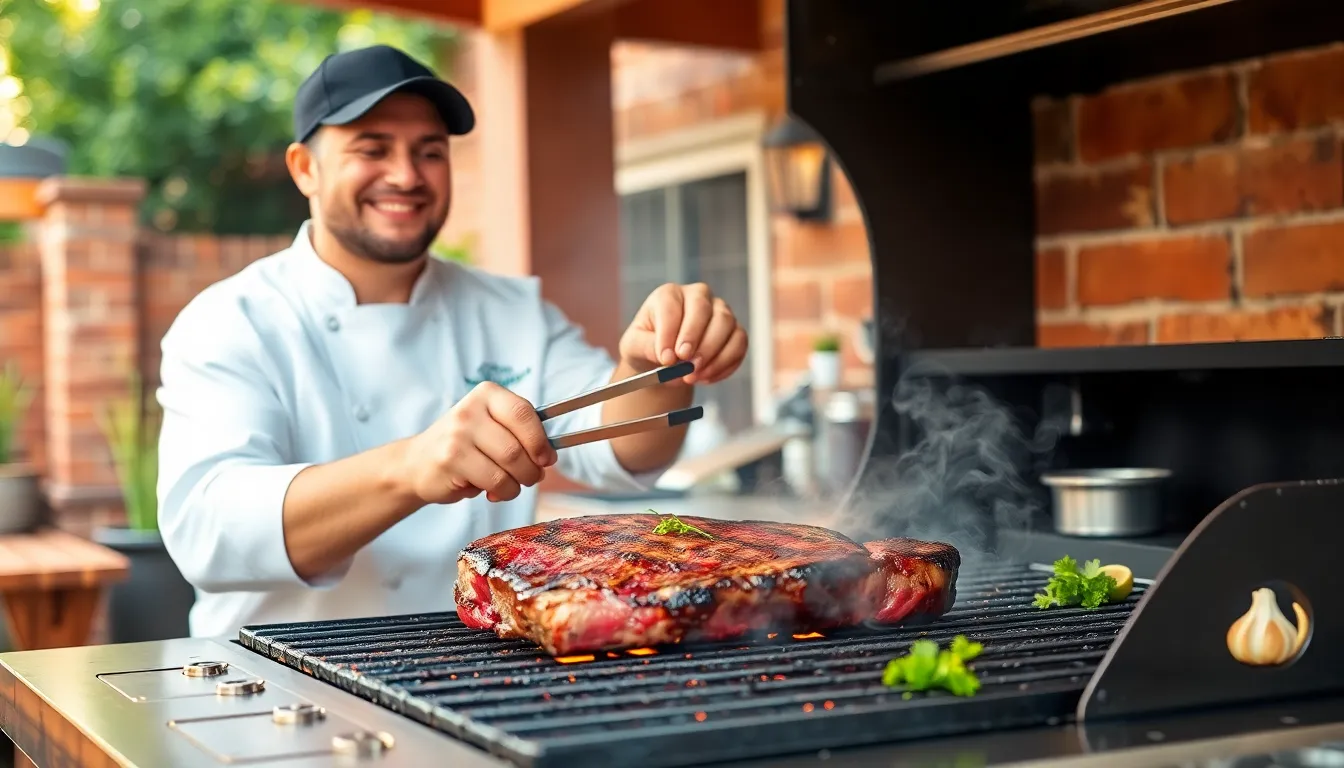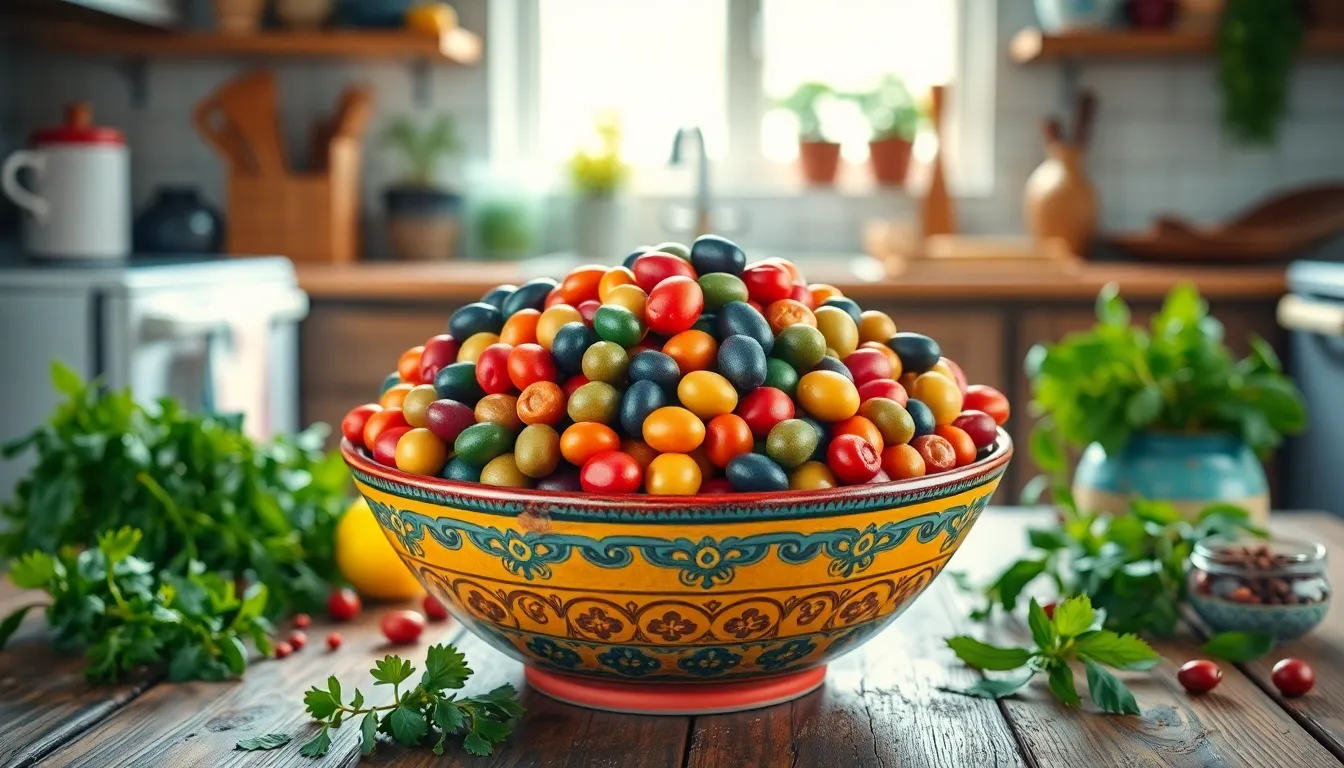When it comes to cooking steak, the options are as juicy as the meat itself. Whether it’s searing, grilling, or sous-vide, mastering these techniques can elevate a simple cut into a culinary masterpiece. Picture this: the sizzle of a perfectly heated grill, the aroma of spices dancing in the air, and that first bite—pure bliss.
Table of Contents
ToggleUnderstanding Steak Cuts
Steak cuts vary in tenderness, flavor, and cooking method. Familiarity with these cuts helps in selecting the right one for specific preparations.
Popular Steak Cuts
Ribeye stands out for its marbling, delivering rich flavor. New York Strip offers a balance of tenderness and taste, making it widely popular. Filet Mignon ranks among the most tender cuts, ideal for those seeking buttery texture. T-bone showcases both strip and tenderloin, providing the best of both worlds. Skirt steak enriches tacos and stir-fries with its bold flavor. Flank steak, though lean, can be delicious when marinated and sliced against the grain.
Choosing the Right Cut for Cooking
Selecting the cut depends on the cooking method and desired flavor. Grilling benefits from thicker cuts like ribeye or T-bone, which hold up well. For quick cooking techniques, such as sautéing, flank and skirt steak excel. Sous-vide complements cuts like filet mignon, enhancing tenderness. When seeking robust flavor, choose cuts with more marbling. Ensure to consider portion sizes; smaller cuts work well for individual servings, while larger cuts serve multiple people effectively.
Essential Steak Cooking Techniques
Steak can become a culinary masterpiece with the right cooking techniques. Understanding methods like grilling, pan-searing, and sous vide elevates the flavor and texture of any steak cut.
Grilling
Grilling enhances the natural flavors of steak while providing a smoky char. For optimal results, preheat the grill to a high temperature. Searing each side for about three to five minutes creates a nice crust, locking in juices. Thicker cuts, such as ribeye or T-bone, thrive on the grill, while leaner cuts like flank steak benefit from quick cooking. Additionally, use a meat thermometer to achieve desired doneness, ensuring a perfect medium-rare at 130°F.
Pan-Searing
Pan-searing offers a rich crust and concentrated flavor, making it ideal for tender cuts. Start by heating a heavy skillet over medium-high heat. Adding oil with a high smoke point allows for effective searing. Cook the steak for four to six minutes per side, depending on thickness, and baste with butter for extra richness. Filet mignon and New York Strip benefit significantly from this method. Finish in the oven to reach precise doneness without drying out.
Sous Vide
Sous vide allows for precise temperature control, resulting in evenly cooked steak throughout. Sealing the steak in a vacuum bag and immersing it in a water bath at the desired temperature achieves consistent results. Cooking for one to four hours ensures tenderness. After sous vide cooking, a quick sear in a hot pan enhances flavor and texture. This method suits all steak cuts, particularly those needing longer cooking times to become tender, like flank steak.
Seasoning and Marinating
Seasoning and marinating significantly enhance steak flavor and tenderness. Proper techniques bring out the best in any cut of meat.
Simple Seasoning Techniques
Salt and pepper create a classic seasoning base. Heavier seasoning on both sides emphasizes the natural flavors of the steak. Garlic powder, onion powder, and smoked paprika introduce additional depth. Herbs like thyme or rosemary pair well with various cuts. Freshly cracked black pepper adds a spicy note that contrasts beautifully with the meat’s richness. For a simple approach, seasoning steak at least 30 minutes before cooking allows flavors to penetrate the meat effectively. Kosher salt is a preferred choice, as its larger crystals help achieve an even coating.
Marinades That Enhance Flavor
Acidic ingredients, such as vinegar or citrus juice, tenderize the steak while infusing it with flavor. Marinades typically include oil, which promotes moisture retention during cooking. A basic marinade might combine soy sauce, olive oil, garlic, and herbs. Marinade duration varies from 30 minutes to several hours based on the cut; tougher cuts benefit from longer marinating times. Balancing sweet, salty, and acidic components creates a well-rounded flavor profile. Marinating overnight amplifies depth, especially for cuts like flank or skirt steak.
Doneness Levels
Determining the perfect doneness level significantly impacts the steak’s flavor and texture. Accurate measurement ensures that steak is cooked to individual preferences, enhancing the dining experience.
Measuring Doneness
Various methods exist for measuring doneness. The most reliable technique is using an instant-read meat thermometer. Internal temperatures signify different doneness levels: 125°F for rare, 135°F for medium rare, 145°F for medium, 160°F for medium well, and 170°F for well done. Another approach involves the touch test, where the feel of the meat correlates to the desired tenderness. Armed with knowledge about these methods, home cooks can achieve consistent results.
Common Doneness Terms
Familiar terms describe steak doneness. “Rare” denotes a cool, red center, emphasizing juiciness. “Medium rare” features a warm, red center for a balance of juiciness and flavor. “Medium” indicates a pink center with firmer texture. “Medium well” has a slight hint of pink and increased dryness. Finally, “well done” offers no pink, resulting in a drier and firmer steak. Understanding these terms allows for effective communication in steak preparation.
Tips for Perfect Steak
Perfect steak cooking relies on several essential techniques to elevate flavor and texture.
Resting the Steak
Resting steak after cooking enhances juiciness and tenderness. A minimum of 5 minutes is recommended, allowing juices to redistribute throughout the meat. During this time, steak continues to cook slightly due to residual heat, ensuring optimal doneness. Covering the steak loosely with aluminum foil prevents heat loss while resting. This simple step significantly impacts the overall flavor profile and enjoyment of the meat.
Slicing Techniques
Slicing techniques affect how steak’s texture and flavor are perceived. Cutting against the grain creates shorter muscle fibers, resulting in a more tender bite. First, identify the direction of the grain by examining the meat. Ensure that each slice is uniform, ideally around half an inch thick. This consistency promotes even cooking and presentation. A sharp knife is crucial for clean cuts, enhancing visual appeal and taste with each portion.
Mastering steak cooking techniques elevates the dining experience from ordinary to extraordinary. By understanding the nuances of each method whether grilling searing or sous vide anyone can create a steak that delights the senses. Selecting the right cut and employing effective seasoning and marinating strategies further enhances flavor and tenderness.
Determining the perfect doneness is crucial and using a meat thermometer ensures consistent results. Resting the steak before slicing allows juices to redistribute resulting in a more succulent bite. With these insights and techniques anyone can confidently prepare a steak that impresses at any gathering.




